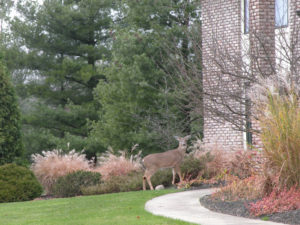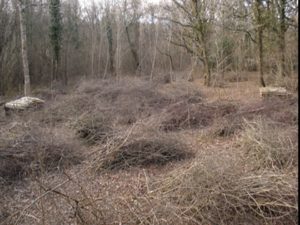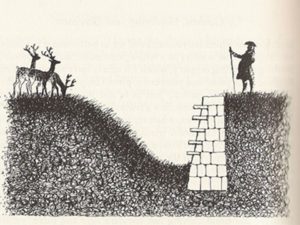
Deer examining plants in suburban Cleveland front yard
Periodically, during the winter, I have found deer scat on my lawn so I know that the deer have been visiting. Last year, I ran out like a crazy woman, shooing them away but I know they’ll be back. Fortunately, I have lots of plants that they don’t like but in the spring, I always know who’s been eating my tulips – thank goodness, not all of them.
 I’ve heard all the arguments about the fact that we have invaded their habitat but as I see it, there are too many and the herds need to be thinned if not moved. There are lots of home remedies that will supposedly keep them away but everything I’ve read indicates that these remedies only work for a limited period because deer are very adaptable. These remedies, like human hair (must be in net bag), garlic, strong smelling soap, hot pepper, coyote urine, dryer sheets, and eggs, need to be reapplied frequently and changed frequently. Many of the deer-repelling sprays on the market use many of these ingredients.
I’ve heard all the arguments about the fact that we have invaded their habitat but as I see it, there are too many and the herds need to be thinned if not moved. There are lots of home remedies that will supposedly keep them away but everything I’ve read indicates that these remedies only work for a limited period because deer are very adaptable. These remedies, like human hair (must be in net bag), garlic, strong smelling soap, hot pepper, coyote urine, dryer sheets, and eggs, need to be reapplied frequently and changed frequently. Many of the deer-repelling sprays on the market use many of these ingredients.
Before I start talking about specific types of plants that they tend not to eat, I want to talk about some strategies for keeping them out of the garden. Humans love to strike out on an adventure but deer are very much creatures of habit. Learn their routes. Amazingly, if a plant they love is not on the route, they might ignore it.

Since deer tend to walk only where the footing is secure, you may be able to alter their route by collecting and placing deadwood in the midst of their route or staking pieces of chicken wire where you see scat or where you know their paths are. If you have an area not seen by the public, you stack pallets on which deer are afraid to walk or cannot jump.
 Large, barking dogs who run loose on your property are one of the best deterrents, assuming that you are a dog lover. Dogs that are chained or on a run are not effective deterrents in spite of their barking because deer have been shown to learn the range of chained dogs.
Large, barking dogs who run loose on your property are one of the best deterrents, assuming that you are a dog lover. Dogs that are chained or on a run are not effective deterrents in spite of their barking because deer have been shown to learn the range of chained dogs.

Less or no fertilizer
Remember that fertilizer promotes succulent growth (tasty tidbits) so either lessen or abandon it.
Scare tactics may work for a while but they vary in effectiveness. Many of the ultrasound devices emit sounds at wavelengths animals can hear (above 20 kilohertz) but people can’t. The problem is that deer hear in a different range, from two to six kilohertz. Motion activated lights need to be mounted on a stand that can be moved every few days; they will lose their effectiveness if not moved. The same is true for motion activated sprinklers.

English ha-ha (cottageandgarden.com)

Terraced gardens on hillside
One of the best strategies is creating levels with terraces or sunken beds (English ha-ha) because deer don’t like to climb.

Colorful wire sun on 8’ high rusted steel fence; flowers echo fence colors

Double fence at Arcadia Farms in Michigan (arcadia-farms.net) affects depth perception; doesn’t have to be fancy; two fences should be three to five feet apart
A last resort is fencing that is either very high or affects depth perception. The theory is that deer won’t jump both high and broad in the same jump nor will they jump into areas where they cannot see a landing place.
Next time, I’ll actually discuss types of plants from which they tend to stay away.


3 Comments